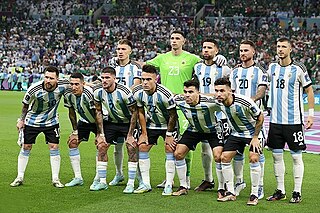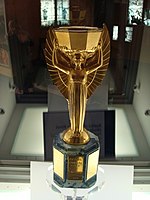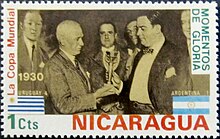
The FIFA World Cup, often simply called the World Cup, is an international association football competition among the senior men's national teams of the members of the Fédération Internationale de Football Association (FIFA), the sport's global governing body. The tournament has been held every four years since the inaugural tournament in 1930, with the exception of 1942 and 1946 due to the Second World War. The reigning champions are Argentina, who won their third title at the 2022 tournament.

The 1966 FIFA World Cup was the eighth FIFA World Cup, a quadrennial football tournament for men's senior national teams. It was played in England from 11 to 30 July 1966. England defeated West Germany 4–2 in the final to win their first ever World Cup title. The final was level at 2–2 after 90 minutes and went to extra time, when Geoff Hurst scored two goals to complete his hat-trick, the first to be scored in a men's World Cup final. England were the fifth nation to win the event, and the third host nation to win after Uruguay in 1930 and Italy in 1934. Two time reigning champions Brazil failed to get past the group stages as they were defeated by Hungary and Portugal. It was the first time that defending champions were eliminated in the group stages after Italy in 1950. This would not occur again until 36 years later. It was opened by Queen Elizabeth II during the opening ceremony.

The Brazil national football team, nicknamed Seleção Canarinha, represents Brazil in men's international football and is administered by the Brazilian Football Confederation (CBF), the governing body for football in Brazil. They have been a member of FIFA since 1923 and a member of CONMEBOL since 1916.

Jules Rimet was a French football administrator who was the 3rd President of FIFA, serving from 1921 to 1954. He is FIFA's longest-serving president, in office for 33 years. He also served as the president of the French Football Federation from 1919 to 1942.

The Sociedade Esportiva Palmeiras, commonly known as Palmeiras, is a Brazilian professional football club based in the city of São Paulo, in the district of Perdizes. Palmeiras is one of the most popular clubs in South America, with an approximate 21 million supporters and 184,680 affiliated fans. Despite being primarily a football club, Palmeiras competes in a number of different sports. The football team plays in the Campeonato Paulista, the state of São Paulo's premier state league, as well as in the Brasileirão Série A, the top tier of the Brazilian football league system.

The FIFA Women's World Cup is an international association football competition contested by the senior women's national teams of the members of Fédération Internationale de Football Association (FIFA), the sport's international governing body. The competition has been held every four years and one year after the men's FIFA World Cup since 1991, when the inaugural tournament, then called the FIFA Women's World Championship, was held in China. Under the tournament's current format, national teams vie for the remaining 31 slots in a three-year qualification phase. The host nation's team is automatically entered as the first slot. The tournament, called the World Cup Finals, is contested at venues within the host nation(s) over about one month.

A trophy is a tangible, durable reminder of a specific achievement, serving as recognition or evidence of merit. Trophies are most commonly awarded for sporting events, ranging from youth sports to professional level athletics. Additionally, trophies are presented for achievements in Academic, Arts and Entertainment, Business, Military, Professional awards, Community Service, Hunting, and Environmental accomplishments. In many contexts, especially in sports, medals are often given out either as the trophy or along with more traditional trophies.

The National Football Museum is England's national museum of football. It is based in the Urbis building in Manchester city centre, and preserves, conserves and displays important collections of football memorabilia.
The FIFA Club World Cup is an international men's association football competition organised by the Fédération Internationale de Football Association (FIFA), the sport's global governing body. The competition was first contested in 2000 as the FIFA Club World Championship. It was not held from 2001 to 2004 due to a combination of factors in the cancelled 2001 tournament, most importantly the collapse of FIFA's marketing partner International Sport and Leisure (ISL), but since 2005 it has been held every year. Views differ as to the cup's prestige: it struggles to attract interest in most of Europe, and is the object of heated debate in South America.

The Latin Cup was an international football tournament for club sides from the Southwest European nations of France, Italy, Spain, and Portugal. In 1949, the football federations came together and requested FIFA launch the competition. European clubs could not afford hefty travel costs, so competition was staged at the end of every season in a single host country. The competition featured two semi-finals, a third-place play-off, and a final.

Abel Lafleur was a French sculptor who designed and made the FIFA World Cup trophy, first simply called 'Coupe du Monde', later renamed the Jules Rimet Trophy.
The FIFA World Cup was first held in 1930, when FIFA, the world's football governing body, decided to stage an international men's football tournament under the era of FIFA president Jules Rimet who put this idea into place. Jules Rimet was the president of FIFA from 1921 to 1954. Rimet was appreciated so much for bringing the idea of FIFA to life that 1946 the trophy was named the Jules Rimet Cup instead of the World Cup Trophy. The inaugural edition, held in 1930, was contested as a final tournament of only thirteen teams invited by the organization. Since then, the World Cup has experienced successive expansions and format remodeling, with its current 48-team final tournament preceded by a two-year qualifying process, involving over 200 teams from around the world.

Pickles was a black and white collie dog, known for his role in finding the stolen Jules Rimet Trophy in March 1966, four months before the 1966 FIFA World Cup was scheduled to kick off in England.

Silvio Gazzaniga was an Italian sculptor. While working for the Stabilimento Artistico Bertoni company, he created the FIFA World Cup Trophy.

The Jules Rimet Trophy, awarded to the winner of the football World Cup, was stolen in 1966 prior to the 1966 FIFA World Cup in England. The trophy was later recovered by a dog named Pickles who was later commended and gained a cult following for his heroism. One man was convicted for being involved but other possible culprits are still unknown. The trophy was eventually won by the hosting team England.

Ottorino Barassi was an Italian sports official.

The 1970 FIFA World Cup final was held on Sunday, 21 June, in the Estadio Azteca in Mexico City, to determine the winner of the 1970 FIFA World Cup. This final, between Brazil and Italy, marked the first time that two former world champions met in a final; Italy had previously won the World Cup in 1934 and 1938, while Brazil won in 1958 and 1962.

This is a record of Uruguay's results at the FIFA World Cup. Uruguay have won four FIFA-organized World Football Championships. They won the first World Championship organized by FIFA under the Olympic Committee umbrella with true representation from all continents; before then, football in the Olympics comprised only European teams. Uruguay then won the next two World Cups in which they participated; these tournaments, the 1930 and 1950 FIFA World Cups, were fully independent from the Olympics and employed clear rules distinguishing professional and amateur football players. Since 1924 marked the beginning of true international football competition, organized by FIFA, FIFA recognizes Uruguay as four-time world champions and allows the team to wear four stars on their uniforms during official international football competitions. Uruguay hosted and won the first FIFA World Cup in 1930, beating Argentina 4–2 in the final. They won their second and last title in 1950, upsetting host Brazil 2–1 in the final match. The team have qualified for fourteen World Cups, reaching the second round in ten, the semi-finals five times, and the final twice. They also won the gold medal in Olympic football twice, in 1924 and 1928, before the creation of the World Cup. Uruguay won the 1980 Mundialito, a tournament comprising former World Cup champions hosted in Uruguay to celebrate the 50th anniversary of the first World Championship. Uruguay is one of the most successful teams in the world, having won nineteen FIFA official titles: two World Cups, two Olympic Games, and fifteen Copa América championships.

At the 1970 FIFA World Cup, Brazil participated for the 9th time in the event. The country remained as the only national team to have participated in every installment of the FIFA World Cup. The 1970 Brazil line-up is often considered to be the greatest football team in history.
The Jules Rimet Trophy was stolen for the second time in 1983. Unlike the first theft in 1966, the trophy has never been recovered.






















